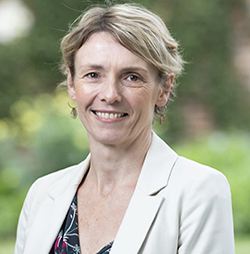Strengthening and Responding


Anne Grindrod, Deputy Chairman
In July 2019, I became Acting Chairman of FRRR, following the retirement of the Rt Hon Ian Sinclair AC. I am delighted that both he and Bill Kelty AC agreed to become Patrons of FRRR and maintain their important association with the Foundation.
The Board was pleased to welcome three new directors – the Hon Simon Crean and the Hon John Sharp AM, as well as Simon Atkinson, who replaced Dr Stephen Kennedy PSM as the Australian Government’s representative.
The launch of our Disaster Resilience and Recovery Fund at a Parliamentary breakfast hosted by the Deputy Prime Minister in August, was timely. Little could we have known that the devastating bushfire season that lay ahead would begin in September.
By focusing on sustainable community-led recovery, FRRR’s team ensured grants reached affected communities. Program Managers spent time on the ground in many regions, increasing our collective understanding of emerging and continuing needs.
At an organisational level, the Board and staff conducted a review of FRRR’s strategy. This work resulted in a five-year strategic plan which aims to strengthen social, economic, environmental, and cultural vitality for smaller and more remote communities, with a focus on targeting investment in the people, places, and disaster and climate resilience of remote, rural, and regional Australia. FRRR will continue as a grantmaker, playing a crucial role in leveraging and brokering support for remote and rural communities. Increasingly we will draw on our insights and learnings from the last twenty years to both enhance capacity in communities, and to drive best practice.
Despite the year we’ve had, I am confident of a positive future ahead of us, if we continue to trust local leaders to identify community-led solutions to the many challenges ahead for remote and rural communities throughout Australia.
Anne Grindrod, Deputy Chairman

Tim Fairfax, Chairman
I am immensely proud to lead this organisation – the only national foundation specifically focused on ensuring social and economic strength in remote, rural and regional Australia.
The first half of 2020 was a testing time for so much of country Australia. Although there was good rainfall in some places during the year, the effects of drought are ongoing in many places, and even where it has rained, true recovery will take years.
Australia also experienced severe bushfires, stretching across nearly every state and territory. As they have time and again, FRRR’s generous donor partners stepped forward, committing funds for both immediate and long-term recovery.
Then came COVID-19, which affected every aspect of life. As with a natural disaster, the impacts of this pandemic are yet to be fully understood, but we stand ready to support communities.
I acknowledge and thank FRRR’s employees, under the very capable leadership of CEO Natalie Egleton, for the way in which they have responded. We know it has been extremely challenging on many fronts, and the Board sincerely appreciates your efforts.
I thank Anne Grindrod for serving as Acting Chairman for the first half of the reporting year. I greatly appreciated her leadership and am fortunate to continue to work closely with her as the Deputy Chairman, especially at such a unique juncture.
I also acknowledge and thank the thousands of community leaders, donor partners, our dedicated staff, Board members and committee members, both past and present, who have all worked so hard to make FRRR a success.
Thank you again for your support, and I trust that you will enjoy this Review, which offers a glimpse into the work of the Foundation this past financial year.
Tim Fairfax AC, Chairman
Just want the highlights?

20th Anniversary
Celebrating the people and places that have shaped FRRR over the past 20 years.

At a Glance
2019-20 was record year for FRRR, both in terms of donations and grants awarded.

Grounded & Connected
Connecting with and amplifying the voices of remote, rural and regional communities.

How FRRR works
Inspiring community stories
Victoria
Nearly a quarter of all funds granted in FY20 were distributed in Victoria, via 20 different programs. Strengthening Rural Communities program was in high demand, with more than $590,000 distributed to 67 community groups. Find out more about how these grants supported very different needs. The effects of drought were also felt in Victoria, with more than $870,000 awarded via 33 grants.
New South Wales
NSW received the largest proportion of funding support, with most awarded to projects relating to disaster resilience and recovery, at nearly 65% or $4,064,171. Almost 42% of all funding was through the Tackling Tough Times Together program. Read and watch how some of these communities are managing the drought and investing in their youth.
South Australia
Our reach continued to extend beyond the eastern seaboard, with a year-on-year increase in grants awarded in South Australia (up 58%). This was due, in part, to the worsening drought, with $990,702 supporting 32 projects distributed via the Tackling Tough Times Together program. As you can read social connection is critically important to the communities we support.
Queensland
QLD received 16% of all funding this hear, nearly half of which supported projects in remote or very remote communities. Of this, 67% (59 grants, $1,657,380) were through the Tackling Tough Times Together program, reflecting the extensive impact of the drought. Learn the importance of community engagement and how art can help in disaster prone communities.
Western Australia
In WA we saw a 26% increase year-on-year in the number of projects funded, which shows that our targeted, engagement strategy is beginning to work. With small populations and remote locations, many WA communities experience inequity in access to services and opportunities. The solutions lie in harnessing local knowledge.
Northern Territory
There was a 150% increase in projects funded in the NT this year, compared to last financial year. We continue to actively strive to improve our networks, awareness and reach. Isolation, inequality in access to services and food security are real issues in NT. As you will discover, simply planting a few fruit trees can make an enormous difference.
Tasmania
Our move to a state-based staffing, increasing the time spent with community leaders and not-for-profit organisations, and delivering more grant-seeker workshops and project development support is paying off with a year-on-year increase in the number of grants to TAS up by 100%. Despite COVID-19, TAS communities continued to prepare for the next disaster and embrace technology to network, collaborate and socialise.
New Approaches – DR:FR and IRCF
Two new programs are responding to system level challenges and opportunities identified by FRRR and its donor partners, through their work with remote, rural and regional communities. We believe our role is to trust local people, to mentor and support them. This is the approach we are using in both the Disaster Resilient: Future Ready and Investing in Rural Community Futures programs, with strong community engagement at the heart.
Looking back: 20 years of granting
Over our 20 years, FRRR has awarded grants around 11,000 grants in 1,993 postcodes across Australia. One of them is 4605 – Murgon, in south-east Queensland, where we’ve awarded nearly $280,000 via 35 grants to 11 organisations.
Read more to learn how FRRR and the Murgon community has worked together to support the needs of the region through some of the most challenging times.
We acknowledge and extend our appreciation to the Dja Dja Wurrung People, the Traditional Owners of the land on which our Foundation is located in Bendigo, and to the Traditional Custodians of the lands on which our programs are assessed and delivered.
We pay respect to their ancient and continuing cultures, their connections to the land, and to the Elders, past, present and emerging.
Photo: Jonathan Lim


